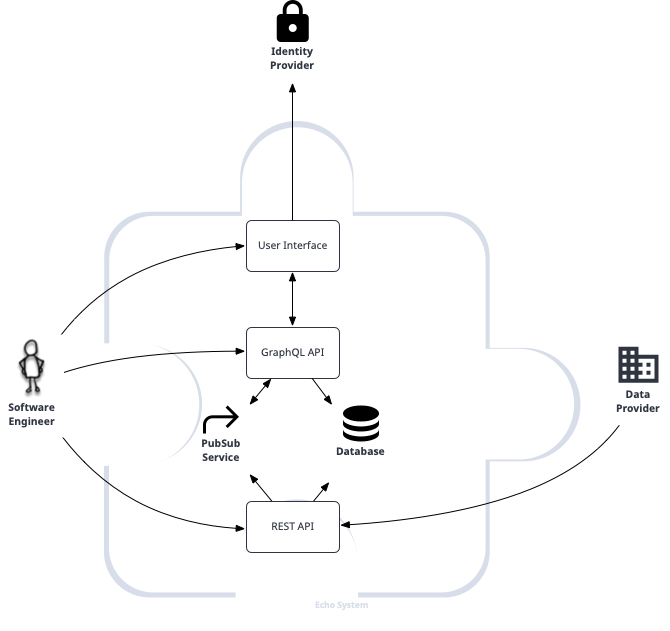Architecture
1. System Context
The Echo system collaborates with the following personas and systems:

- Software Engineer
-
Software engineers interact with Echo system to profit from its services. For example, they create endpoints that capture HTTP requests so that they can analyse them (see User Journeys). They interact with the system via the following interfaces:
-
user interface
-
REST API
-
GraphQL API
-
- Identity Provider
-
The Echo system must ensure that a software engineer only sees the data that belongs to him. For example, a software engineer must only see and manage his own endpoints. And a software engineer must only see the requests captured by his own endpoints. To ensure that, the Echo system must identify software engineers. To identify software engineers, the system uses identity providers like GitHub, Google, or Facebook.
- Data Provider
-
Software engineers instruct their data providers to call endpoints in the Echo system. The endpoints in the Echo system capture the data providers' requests. The software engineers then analyse the captured requests. Data providers are unknown to the Echo system.
2. System Components
The Echo system consists of the following components:

- User Interface
-
Software engineers access and manage their data via the user interface. For example, they can manage their endpoints and analyse the HTTP requests that were captured by their endpoints. The user interface uses the GraphQL API to read and write data in the Echo system. The user interface authenticates the software engineers using identity providers.
- GraphQL API
-
The GraphQL API allows querying data, mutating data and subscribing to data in the Echo system. The Echo user interface uses the GraphQL API to query, display and mutate data. Software engineers can use the GraphQL API directly to access and manage their data in the Echo system.
The GraphQL API interacts directly with:
-
the database that stores the data
-
the PubSub server to publish events across multiple instances of the GraphQL API
-
- REST API
-
The REST API exposes the software engineers' endpoints. When a data provider pushes data to a software engineer’s endpoint, the data provider executes a HTTP request against the REST API.
Further, the REST API allows querying and mutating data in the Echo system. Software engineers can use the REST API directly to access and manage their data in the Echo system.
The REST API interacts directly with:
-
the database that stores the data
-
the PubSub server to publish events across multiple instances of the GraphQL API
-
- Database
-
The database component stores the software engineers' data like endpoints and capture requests.
- PubSub Service
-
GraphQL API clients can subscribe to events. When a data provider calls an Echo endpoint, the GraphQL API will publish an event to subscribed clients. To ensure that all subscribed clients receive all the events they subscribed for, the system must use a PubSub service. The GraphQL API and the REST API must share the same PubSub service.